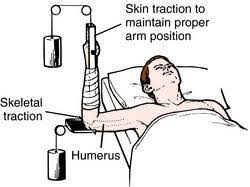A nurse is providing teaching to a client who has a prescription for heat therapy for the treatment of cellulitis of the right lower leg. Which of the following client statements indicates an understanding of the teaching?
"I will place my leg under a heat lamp every 3 hours."
"I will wrap a warm, wet towel around my right calf every 4 hours."
"I keep a heating pad on the calf of my right leg when I am lying down."
"I will sit on the side of the tub and soak my right leg two times every day."
The Correct Answer is B
Choice A reason:
Placing the leg under a heat lamp every 3 hours is not recommended for the treatment of cellulitis. Heat lamps can cause burns and excessive drying of the skin, which may worsen the condition.
Choice B reason:
Wrapping a warm, wet towel around the affected area is a safe and effective way to apply heat therapy for cellulitis. It can help improve blood flow and relieve discomfort without the risk of burns associated with dry heat sources.
Choice C reason:
Using a heating pad directly on the skin, especially when lying down, can increase the risk of burns and is not recommended for treating cellulitis. Heating pads can provide uneven heat and may exacerbate swelling and inflammation.
Choice D reason:
Soaking the leg in water is not typically advised for cellulitis, especially if there are open wounds or breaks in the skin. Immersion in water can introduce new bacteria to the affected area and potentially worsen the infection.
Nursing Test Bank
Naxlex Comprehensive Predictor Exams
Related Questions
Correct Answer is C
Explanation
Choice A reason:
Skin traction is indeed less restrictive than skeletal traction, allowing for more mobility. It is applied using bandages or adhesive material to the skin, which can be removed or adjusted more easily than the pins or screws used in skeletal traction. This type of traction is typically used for short-term treatment before surgery or when the injury is less severe.
Choice B reason:
Discomfort levels can vary depending on the individual and the specific circumstances of the traction. However, skin traction is generally considered to be less painful than skeletal traction because it is less invasive and applies less force. Skeletal traction, which involves the insertion of pins or wires directly into the bone, is likely to cause more discomfort due to the invasive nature of the procedure.
Choice C reason:
Skeletal traction is more appropriate for reducing fractures, especially in cases where a greater force is needed to align the bones. It involves the surgical insertion of pins or wires directly into the bone, allowing for a stronger and more stable pull that is necessary for the realignment of complex fractures.
Choice D reason:
Skeletal traction carries a higher risk of infection compared to skin traction because it is more invasive. The insertion of pins or wires into the bone creates a potential entry point for bacteria, which can lead to infection at the site of insertion.

Correct Answer is C
Explanation
Choice A reason: The use of erythropoiesis-stimulating agents (ESAs) is indicated for anemia due to chemotherapy¹. However, the client's hemoglobin (Hgb) level is 12.1 g/dL, which is within the normal range (normal: 12-15.5 g/dL for women). Therefore, administering an ESA is not indicated based on the Hgb level provided.
Choice B reason: A diet with increased protein can be beneficial for patients undergoing chemotherapy as it helps in tissue repair and immune system function. However, the client's albumin level is 4.5 g/dL, which falls within the normal range (normal: 3.4-5.4 g/dL), suggesting adequate protein intake. Thus, there is no indication that the client requires an increased protein diet based on the albumin level provided.
Choice C reason: The client's white blood cell (WBC) count is 1,400/mm³, which is below the normal range (normal: 4,500-11,000/mm³). This condition, known as leukopenia, significantly increases the risk of infection³. Therefore, the nurse should prioritize monitoring for signs of infection and implementing infection control measures.
Choice D reason: The client's platelet count is 170,000/mm³, which is within the normal range (normal: 150,000-450,000/mm³). Although cisplatin can cause thrombocytopenia, the current platelet count does not indicate an increased risk for bleeding⁴. Therefore, this choice is not correct based on the platelet count provided.
Whether you are a student looking to ace your exams or a practicing nurse seeking to enhance your expertise , our nursing education contents will empower you with the confidence and competence to make a difference in the lives of patients and become a respected leader in the healthcare field.
Visit Naxlex, invest in your future and unlock endless possibilities with our unparalleled nursing education contents today
Report Wrong Answer on the Current Question
Do you disagree with the answer? If yes, what is your expected answer? Explain.
Kindly be descriptive with the issue you are facing.
